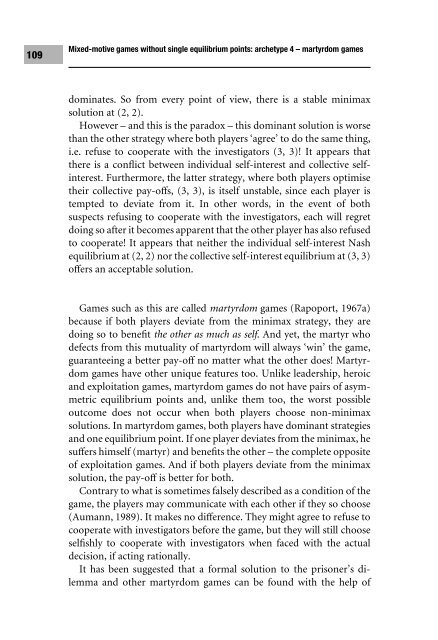Decision Making using Game Theory: An introduction for managers
Decision Making using Game Theory: An introduction for managers
Decision Making using Game Theory: An introduction for managers
- No tags were found...
Create successful ePaper yourself
Turn your PDF publications into a flip-book with our unique Google optimized e-Paper software.
109Mixed-motive games without single equilibrium points: archetype 4 – martyrdom gamesdominates. So from every point of view, there is a stable minimaxsolution at (2, 2).However – and this is the paradox – this dominant solution is worsethan the other strategy where both players ‘agree’ to do the same thing,i.e. refuse to cooperate with the investigators (3, 3)! It appears thatthere is a conXict between individual self-interest and collective selfinterest.Furthermore, the latter strategy, where both players optimisetheir collective pay-oVs, (3, 3), is itself unstable, since each player istempted to deviate from it. In other words, in the event of bothsuspects ref<strong>using</strong> to cooperate with the investigators, each will regretdoing so after it becomes apparent that the other player has also refusedto cooperate! It appears that neither the individual self-interest Nashequilibrium at (2, 2) nor the collective self-interest equilibrium at (3, 3)oVers an acceptable solution.<strong>Game</strong>s such as this are called martyrdom games (Rapoport, 1967a)because if both players deviate from the minimax strategy, they aredoing so to beneWt the other as much as self. <strong>An</strong>d yet, the martyr whodefects from this mutuality of martyrdom will always ‘win’ the game,guaranteeing a better pay-oV no matter what the other does! Martyrdomgames have other unique features too. Unlike leadership, heroicand exploitation games, martyrdom games do not have pairs of asymmetricequilibrium points and, unlike them too, the worst possibleoutcome does not occur when both players choose non-minimaxsolutions. In martyrdom games, both players have dominant strategiesand one equilibrium point. If one player deviates from the minimax, hesuVers himself (martyr) and beneWts the other – the complete oppositeof exploitation games. <strong>An</strong>d if both players deviate from the minimaxsolution, the pay-oV is better <strong>for</strong> both.Contrary to what is sometimes falsely described as a condition of thegame, the players may communicate with each other if they so choose(Aumann, 1989). It makes no diVerence. They might agree to refuse tocooperate with investigators be<strong>for</strong>e the game, but they will still chooseselWshly to cooperate with investigators when faced with the actualdecision, if acting rationally.It has been suggested that a <strong>for</strong>mal solution to the prisoner’s dilemmaand other martyrdom games can be found with the help of
















